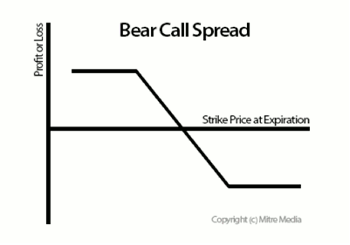With a well-defined maximum profit and loss, those using this strategy are shielded from unlimited gains or losses, writes Justin Kuepper of ETFdb.com.
Exchange-traded funds (“ETFs”) provide investors with an easy way to reach nearly every corner of the stock market. Those that wish to implement targeted strategies may want to consider enhancing their ETF investing with equity/stock options. These tools make it easier to control risk and better generate profits during almost any market condition.
In this article, we’ll take a look at the bear call spread strategy, which lets investors control risk and profit from moderately bearish market conditions.
What Is a Bear Call Spread Strategy?
Suppose that you believe that the S&P 500 SPDR (SPY) will fall over the next month, but you’re not quite sure enough to short sell the stock. After all, short selling involves assuming the risk of unlimited losses if the index rises in value. One way to bet on a decline in SPY’s value with a very controlled risk-to-reward profile is to use the bear call spread strategy.
By purchasing one out-of-the-money call option and selling one in-the-money call option, you can create a credit spread that makes money when the index falls in value. The strategy also enables you to limit your losses to the difference between the call options, while the upside is limited to the net premiums received when the position is first established.
The bear call spread option diagram looks like this:

Who Is the Bear Call Spread Strategy Right For?
The bear call spread strategy is ideal for investors who believe an ETF will move lower over a given period of time, but aren’t confident enough to short sell or wish to absolutely control the potential profit or loss on the trade. Unlike the bear put spread that involves a net debit, the bear call spread is ideal for investors that wish to realize their profit upfront.
Given these dynamics, the bear call spread strategy is considered to be moderately bearish in nature. The strategy caps maximum profits and losses to create a very controlled trade, relative to outright short selling or more aggressive bearish strategies like writing naked put options.
What Are the Risks/Rewards?
The bear call spread strategy has a very well-defined risk to reward profile, given that both the maximum profits and losses are capped. For investors, the key breakeven point to watch and consider can be calculated by adding the strike price of the short call option to the net premiums received when entering into the position (e.g. the credit spread).
The bear call spread strategy’s maximum profits and losses are calculated as follows:
NEXT PAGE: How to Use a Bear Call Spread Strategy
|pagebreak|Maximum Profit is limited to the premiums received from the net credit spread when entering into the position, minus commissions paid to a broker.
Maximum Loss is limited to the difference between the strike price of the long call and the strike price of the short call options, minus the premiums received from entering into the position, plus commissions paid to a broker.
How to Use a Bear Call Spread Strategy
Suppose that you decided to enter into a bear call spread in the aforementioned scenario when the underlying stock was trading at 163.00. To enter the position, you might purchase one out-of-the-money 165 call option for $150 and then write one in-the-money 160 option for $430, resulting in a net credit spread of $280 that represents the position’s max profit potential.
There are three difference scenarios that could then play out over the next month:

The underlying stock could fall below $160 per share and all the call options would expire worthless, enabling you to keep the $280 in premiums received.
The underlying stock could remain even at $163 per share, resulting in the 165 call expiring and the 160 call option being exercised. The 160 call option would create a loss of $300.00, resulting in a net loss of $20 after including the premiums received.
The underlying stock could rally past $165 per share, resulting in both call options being exercised. The 160 short call option would experience a $500 loss before being covered by the 165 long call option, which equates to a $220 overall net loss.
The breakeven point on the position would be equal to $162.80, or the 160 strike price of the short call plus the 2.80 premium received entering into the position.
The Bottom Line
Bear call spreads are a useful strategy for ETF investors looking for a way to profit from an ETF’s downturn in a very controlled manner. With a well-defined maximum profit and loss, investors utilizing this strategy are shielded from unlimited gains or losses. Those looking for a more bearish alternative may want to consider simply writing puts instead, or exploring the bear put spread may provide more desirable economics depending on the situation.
By Justin Kuepper, Contributor, ETFdb.com





















